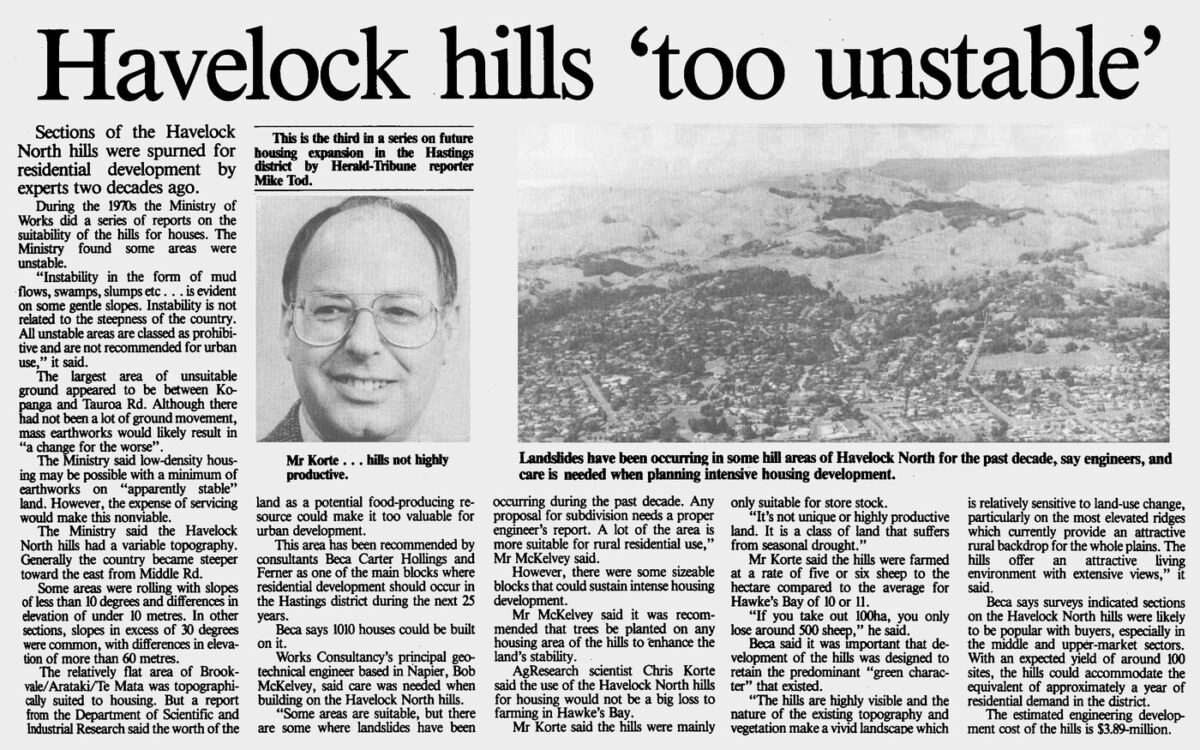Havelock hills ‘too unstable’
This is the third in a series on future housing expansion in the Hastings district by Herald-Tribune reporter Mike Tod.
Sections of the Havelock North hills were spurned for residential development by experts two decades ago.
During the 1970s the Ministry of Works did a series of reports on the suitability of the hills for houses. The Ministry found some areas were unstable.
“Instability in the form of mud flows, swamps, slumps etc. . . is evident on some gentle slopes. Instability is not related to the steepness of the country. All unstable areas are classed as prohibitive and are not recommended for urban use,” it said.
The largest area of unsuitable ground appeared to be between Kopanga and Tauroa Rd. Although there had not been a lot of ground movement, mass earthworks would likely result in “a change for the worse”.
The Ministry said low-density housing may be possible with a minimum of earthworks on “apparently stable” land. However, the expense of servicing would make this nonviable.
The Ministry said the Havelock North hills had a variable topography. Generally the country became steeper toward the east from Middle Rd.
Some areas were rolling with slopes of less than 10 degrees and differences in elevation of under 10 metres. In other sections, slopes in excess of 30 degrees were common, with differences in elevation of more than 60 metres.
The relatively flat area of Brookvale/Arataki/Te Mata was topographically suited to housing. But a report from the Department of Scientific and Industrial Research said the worth of the land as a potential food-producing resource could make it too valuable for urban development.
This area has been recommended by consultants Beca Carter Hollings and Ferner as one of the main blocks where residential development should occur in the Hastings district during the next 25 years.
Beca says 1010 houses could be built on it.
Works Consultancy’s principal geotechnical engineer based in Napier, Bob McKelvey, said care was needed when building on the Havelock North hills.
“Some areas are suitable, but there are some where landslides have been occurring during the past decade. Any proposal for subdivision needs a proper engineer’s report. A lot of the area is more suitable for rural residential use,” Mr McKelvey said.
However, there were some sizable blocks that could sustain intense housing development.
Mr McKelvey said it was recommended that trees be planted on any housing area of the hills to enhance the land’s stability.
AgResearch scientist Chris Korte said the use of the Havelock North hills for housing would not be a big loss to farming in Hawke’s Bay.
Mr Korte said the hills were mainly only suitable for store stock.
“It’s not unique or highly productive land. It is a class of land that suffers from seasonal drought.”
Mr Korte said the hills were farmed at a rate of five or six sheep to the hectare compared to the average for Hawke’s Bay of 10 or 11.
“If you take out 100ha, you only lose around 500 sheep,” he said.
Beca said it was important that development of the hills was designed to retain the predominant “green character” that existed.
“The hills are highly visible and the nature of the existing topography and vegetation make a vivid landscape which is relatively sensitive to land-use change, particularly on the most elevated ridges which currently provide an attractive rural backdrop for the whole plains. The hills offer an attractive living environment with extensive views,” it said.
Beca says surveys indicated sections on the Havelock North hills were likely to be popular with buyers, especially in the middle and upper-market sectors. With an expected yield of around 100 sites, the hills could accommodate the equivalent of approximately a year of residential demand in the district.
The estimated engineering development cost of the hills is $3.89-million.
Photo captions –
Mr Korte… hills not highly productive.
Landslides have been occurring in some hill areas of Havelock North for the past decade, say engineers, and care is needed when planning intensive housing development.












Do you know something about this record?
Please note we cannot verify the accuracy of any information posted by the community.